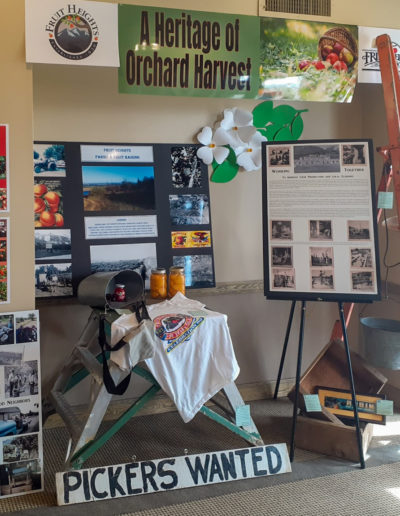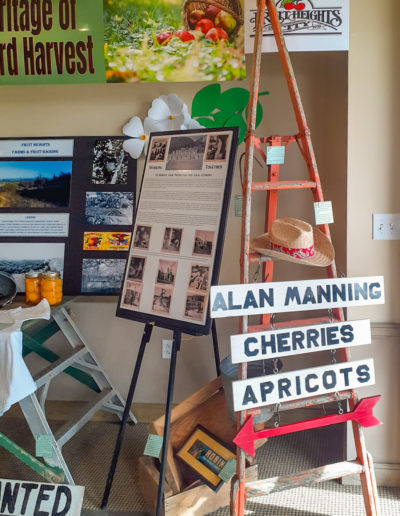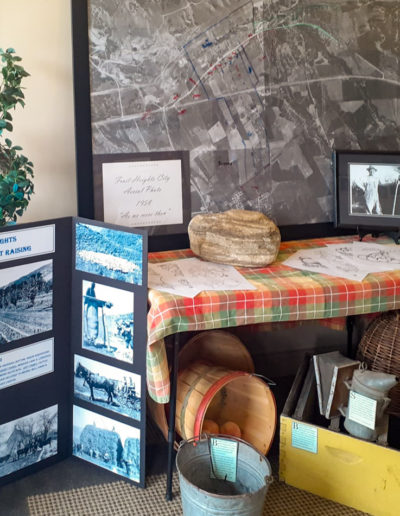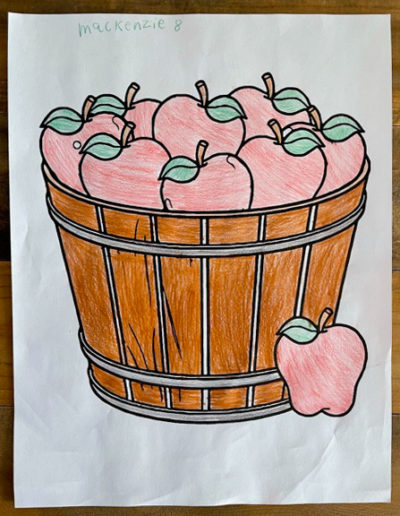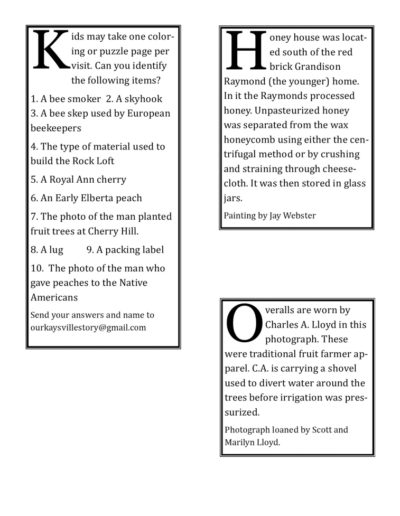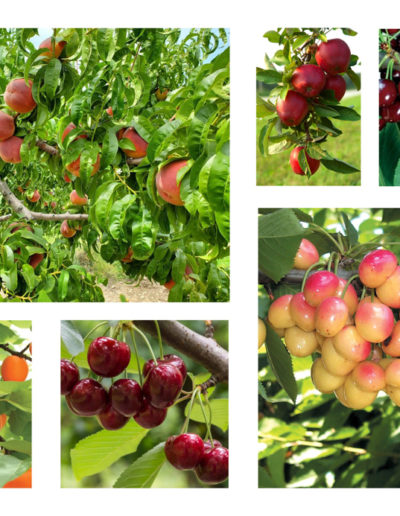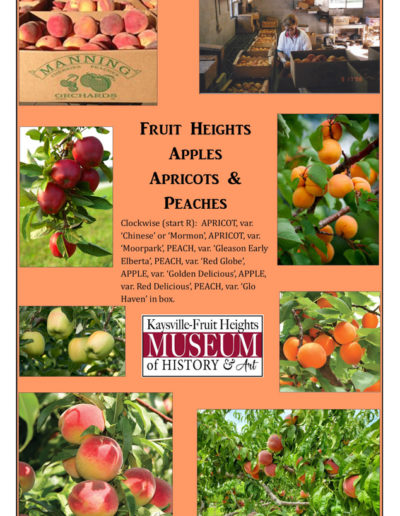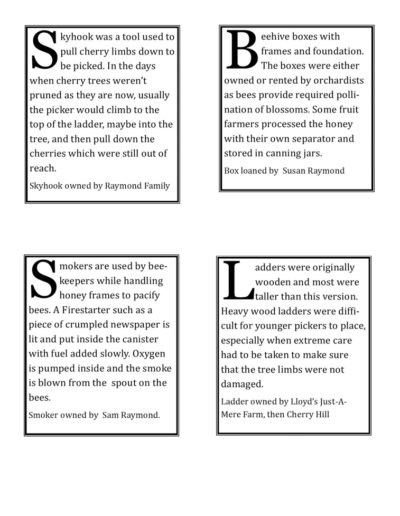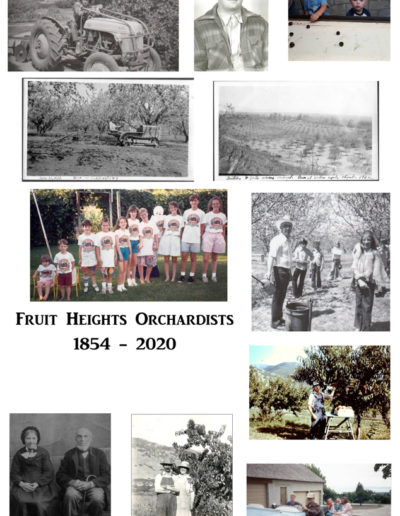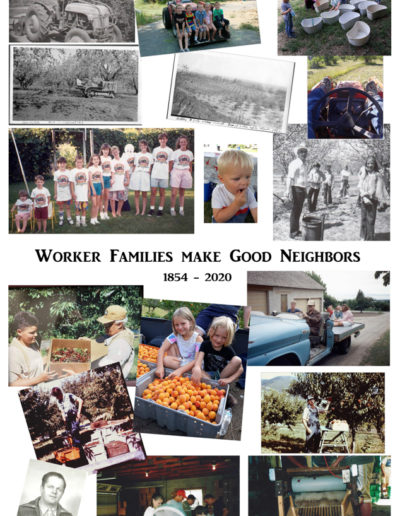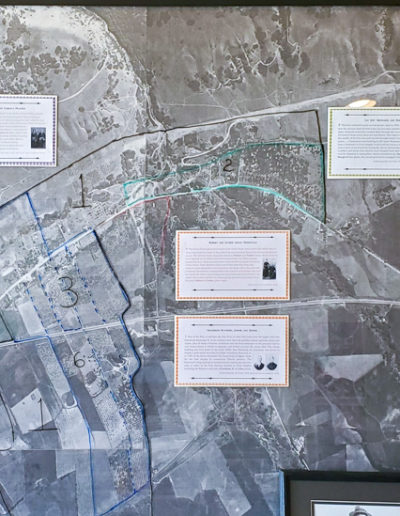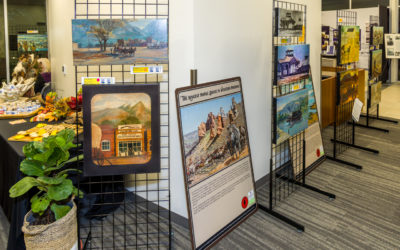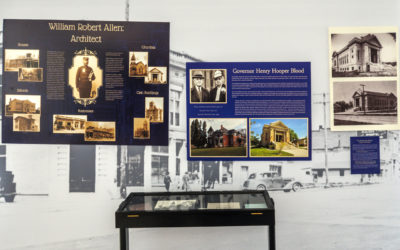
Grandison Raymond, Junior and Senior
1 One of the first, or perhaps the very first, to raise fruit treesnear the upper road was Grandison Raymond, Sr. In his orchard were cherries, peaches, plums, apricots, pears, and apples, plus all kinds of berries.  Grandison was the first beekeeper in the area and had his own honey house in which to separate and further process the sweet fluid. The sturdy building was torn down in the early 1990s. Sam Raymond, his grandson, was proud to display a gold medal awarded his father Grandison Raymond, Jr. in 1908 by the Rocky Mountain Fair Association in Ogden, Utah, for the best display of commercial Elberta peaches. The Raymond’s large land-grant homestead was sold by parcels over time to other of the fruit farming families in Fruit Heights including the Butchers and Josts. Grandison, Sr. & Celia, photo.
Grandison was the first beekeeper in the area and had his own honey house in which to separate and further process the sweet fluid. The sturdy building was torn down in the early 1990s. Sam Raymond, his grandson, was proud to display a gold medal awarded his father Grandison Raymond, Jr. in 1908 by the Rocky Mountain Fair Association in Ogden, Utah, for the best display of commercial Elberta peaches. The Raymond’s large land-grant homestead was sold by parcels over time to other of the fruit farming families in Fruit Heights including the Butchers and Josts. Grandison, Sr. & Celia, photo.

Lee Jost Orchards and Rock Loft
2 The little settlement grew as new people came in. With experimenting, it was found that the soil 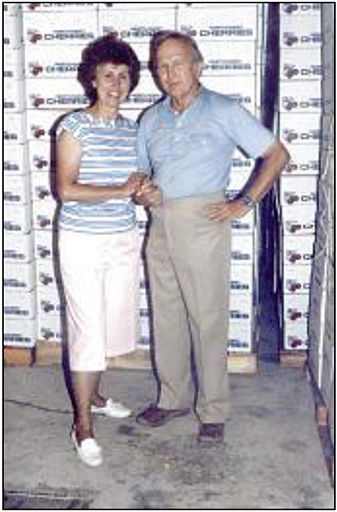 was ideal for fruit trees. Lee Jost once owned twenty-seven acres of cherry trees. Someone must have counted them because the record says there were 1,450 trees. On most of these acres, there are now homes. This region was known over a wide area for the quality of its fruit, and each harvest brought buyers from surrounding states. … A handsome rock building at 209 South Mountain Road has long been a landmark in Fruit Heights. It was built by Jost as a warehouse. It was a scene of much activity during the cherry season when tons of Bing, Lambert, and Queen Ann cherries were shipped fresh and brined in huge vats for shipment to maraschino cherry manufacturers. Dale and Margaret Jost, photo, the second generation managed it for many years.
was ideal for fruit trees. Lee Jost once owned twenty-seven acres of cherry trees. Someone must have counted them because the record says there were 1,450 trees. On most of these acres, there are now homes. This region was known over a wide area for the quality of its fruit, and each harvest brought buyers from surrounding states. … A handsome rock building at 209 South Mountain Road has long been a landmark in Fruit Heights. It was built by Jost as a warehouse. It was a scene of much activity during the cherry season when tons of Bing, Lambert, and Queen Ann cherries were shipped fresh and brined in huge vats for shipment to maraschino cherry manufacturers. Dale and Margaret Jost, photo, the second generation managed it for many years.
(Collett. Kaysville: Our Town. 1976) (Rock Loft: Iconic Landmark. 2019)

Butchers First Planted Elberta Peaches
3 William Butcher was a master fruit grower, and his son Arthur followed him, equally 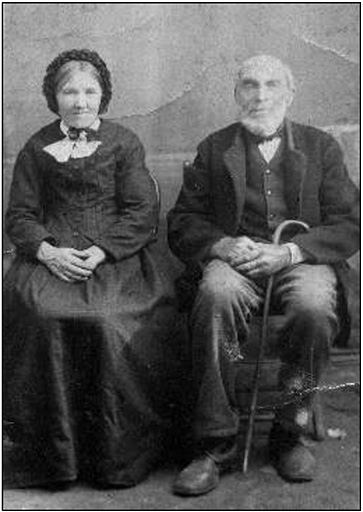 successful as a commercial producer. He planted the first orchard of Gleason Elberta peaches. Of course, in early days the fruit had to be taken by wagon to Salt Lake, the trip starting at one o’clock in the morning. The Depression of the 1930s was a difficult time for fruit growers as often they had to return with their fruit unsold even at 25 to 50 cents a bushel. Arthur was expert at innovations in the areas of grafting, budding, and pruning. William and Emma Butcher, photo, had seven children. Their orchards were divided into strips eventually going to Myron, Alan, and Glenn Manning, Vern Butcher, and Alden Burton. Glenn was at one point the biggest fruit grower in Davis County, harvesting an 80-ton crop. Mary Sherner Talbot of east Kaysville was another a descendant of William Butcher who planted orchards.
successful as a commercial producer. He planted the first orchard of Gleason Elberta peaches. Of course, in early days the fruit had to be taken by wagon to Salt Lake, the trip starting at one o’clock in the morning. The Depression of the 1930s was a difficult time for fruit growers as often they had to return with their fruit unsold even at 25 to 50 cents a bushel. Arthur was expert at innovations in the areas of grafting, budding, and pruning. William and Emma Butcher, photo, had seven children. Their orchards were divided into strips eventually going to Myron, Alan, and Glenn Manning, Vern Butcher, and Alden Burton. Glenn was at one point the biggest fruit grower in Davis County, harvesting an 80-ton crop. Mary Sherner Talbot of east Kaysville was another a descendant of William Butcher who planted orchards.
(Collett. Kaysville: Our Town. 1976) (Rock Loft: Iconic Landmark. 2019)

Robert and Esther Green Homestead
4 The Green Family gave their name to the Green Road, once a farm lane which was so often requested for travel to Kaysville from the mountain bench that the family allowed access. The farmland was originally owned by Robert and Esther Green. Many orchards were planted by the Robert and their descendants, but their primary production was cattle and associated crops needed to supply the needs of the family. Their children Glenn and Archie inherited farm and orchard lands alongside Green Road from the Rock Loft to the east side of Burton Elementary. Grandchildren that lived on Green Road watched the Rock Loft cherry processing plant being built and as it evolved. Like others, the Greens carried on a large haying operation to produce food for cattle. Robert & Esther, photo right.
farm lane which was so often requested for travel to Kaysville from the mountain bench that the family allowed access. The farmland was originally owned by Robert and Esther Green. Many orchards were planted by the Robert and their descendants, but their primary production was cattle and associated crops needed to supply the needs of the family. Their children Glenn and Archie inherited farm and orchard lands alongside Green Road from the Rock Loft to the east side of Burton Elementary. Grandchildren that lived on Green Road watched the Rock Loft cherry processing plant being built and as it evolved. Like others, the Greens carried on a large haying operation to produce food for cattle. Robert & Esther, photo right.
(Rock Loft: Iconic Landmark. 2019)

Driggs, Criddle and Barker Farmland
5 First settled by Samuel and Elizabeth Driggs, the Criddle farm  was located on a strip of land on the south side of where 200 North would later be built. It was later bisected by the highway as were all the orchard strips. This farmland was primarily used for cattle, dairy and hay production, but like most homesteads on the upper bench, it contained a section of fruit trees. When widowed, Elizabeth married John Criddle. Their son James and his wife Elizabeth, photo, ran the farm after their death. Part of their orchards, those east of the highway, later belonged to the Forest Barker Family.
was located on a strip of land on the south side of where 200 North would later be built. It was later bisected by the highway as were all the orchard strips. This farmland was primarily used for cattle, dairy and hay production, but like most homesteads on the upper bench, it contained a section of fruit trees. When widowed, Elizabeth married John Criddle. Their son James and his wife Elizabeth, photo, ran the farm after their death. Part of their orchards, those east of the highway, later belonged to the Forest Barker Family.
(Rock Loft: Iconic Landmark. 2019)

Manning and Gleason, Fruit Pioneers
6 Eli Manning, along with Dr. Sumner Gleason, was one of the early fruit pioneers  in Davis County was Eli Manning. His family settled on what is now property occupied by the Oak Ridge Country Club golf course and surrounding developments. The influence of his orcharding skills was shared through his son, Charles , who came to the benchland east Kaysville and married Nellie Butcher , photo . Dr. Gleason was a gentleman farmer and spearheaded the commercial sales of Gleason peach root stock by contacting a major catalog sales company.
in Davis County was Eli Manning. His family settled on what is now property occupied by the Oak Ridge Country Club golf course and surrounding developments. The influence of his orcharding skills was shared through his son, Charles , who came to the benchland east Kaysville and married Nellie Butcher , photo . Dr. Gleason was a gentleman farmer and spearheaded the commercial sales of Gleason peach root stock by contacting a major catalog sales company.
(Rock Loft: Iconic Landmark. 2019)

Lloyd’s Just-a-Mere Farm and Cherry Hill
7 When Charles A. Lloyd moved from Cache Valley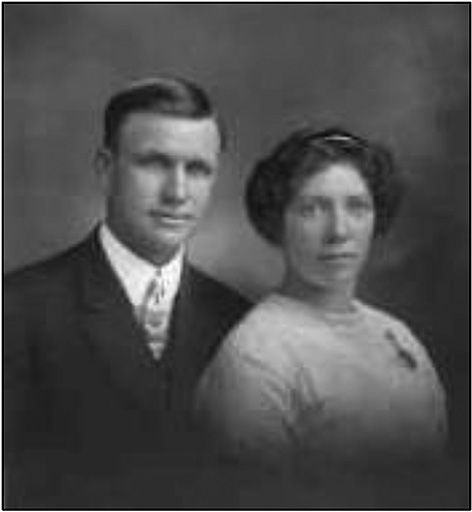 to Farmington with his wife Sena, he was captivated by the beautiful Royal Ann cherries growing on the property. In time he obtained Just-a-Mere Farm which was eventually divided between their two sons, Reed and Grant. The southern half of the farm evolved under the direction of their son Grant Lloyd into Lloyd Trailer Park and then Cherry Hill campground and swimming park. The trailers parked under the cherry trees, and campers were allowed to pick and eat as much as they would like. Reed’s wife Marie began the Pie Pantry located next to the campground. C.A. & Sena, photo right.
to Farmington with his wife Sena, he was captivated by the beautiful Royal Ann cherries growing on the property. In time he obtained Just-a-Mere Farm which was eventually divided between their two sons, Reed and Grant. The southern half of the farm evolved under the direction of their son Grant Lloyd into Lloyd Trailer Park and then Cherry Hill campground and swimming park. The trailers parked under the cherry trees, and campers were allowed to pick and eat as much as they would like. Reed’s wife Marie began the Pie Pantry located next to the campground. C.A. & Sena, photo right.
(Rock Loft: Iconic Landmark. 2019)

Samuel and Ann Ward Orchards
8 Samuel and Ann Ward, photo, moved to the Mountain Road in 1862 where they set up housekeeping and farming near to some of Ann’s family. Like others they lived in a dirt-roofed log house. Samuel told some Native Americans that they could have peaches of a certain tree, so for years when the peaches were ripe, along came the natives for their peaches. They would unbutton their buckskin shirts and fill them, then button up again and ride off with their shirts full of peaches. Their son Robert inherited the property and passed it on to his sons Merlin and Elmer Ward. Unlike the prior tradition of dividing the land lengthwise in strips, the brothers divided the orchard generally along the highway with a section to the east and another to the west.
Native Americans that they could have peaches of a certain tree, so for years when the peaches were ripe, along came the natives for their peaches. They would unbutton their buckskin shirts and fill them, then button up again and ride off with their shirts full of peaches. Their son Robert inherited the property and passed it on to his sons Merlin and Elmer Ward. Unlike the prior tradition of dividing the land lengthwise in strips, the brothers divided the orchard generally along the highway with a section to the east and another to the west.
(Rock Loft: Iconic Landmark. 2019) (Maureen Ward. Samuel Ward History.)

